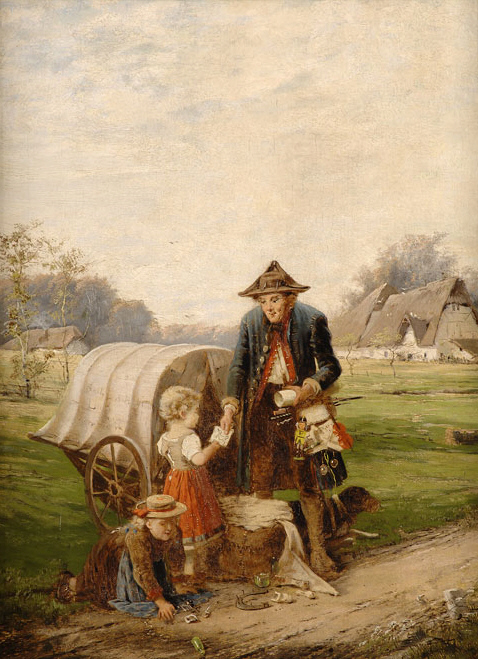A New Book Alleges Parents Murdered Their Children “Routinely”

A harrowing new study into the history of infanticide, child murder, in early-modern Europe, has presented a slate of horrific facts. It turns out child murder was so common in Italy, France and England, that it was practiced “routinely”.
According to a new book by a French-trained Canadian Professor of History, and behavioral historian, Gregory Hanlon, historically in Italy, France and England married couples “routinely killed their children” to control resources and maintain their social status.
Published by Routledge in London, and titled “Death Control in the West 1500-1800: Sex Ratios at Baptism in Italy, France and England,” this stirring new book explores the numbers of infants whose lives were taken, without their murderous parents having been charged with infanticide.
When Humans Killed their Children Without Suffering Grief
Dr. Hanlon, who is a distinguished research professor at Dalhousie University, writes in his new book that Western historians have erroneously derived infantile statistics from the records of criminal trials in which pregnant mothers, or married women fertilized by men other than their husbands, hid their pregnancies.
Hanlon argues that pregnant women carrying unwanted children generally “killed their newborns alone or with female accomplices.” And in most historic cases, according to the new book, “infanticide was a crime leaving no aggrieved party seeking revenge if it was committed right away”.
Where Are All the Girls?
To reach his harrowing conclusions Prof. Gregory Hanlon first measured up the restrictions of all existing works in this field of research. His chief criticism of previous research into historic infanticide is that it never focused on “the sex ratios of infants brought for baptism right after birth.” These records, according to the book, show “startling spikes in male baptisms in the aftermath of famines or diseases,” raising the tough question: “where on Earth are all the girls?”.
By studying historic baptismal registers and ecclesiastical censuses drawn in Italy, France and England, Hanlon’s team demonstrated shared infanticide patterns in regions of Europe ruled by “Catholics, Calvinists, and Anglicans.” The new research suggests that in rural Tuscany, for example, victims of infanticide represented “up to a third of the total number of live births.”

One of the most famous accounts of attempted infanticide is the story of Romulus and Remus, here presented by Peter Paul Rubens. (Public Domain)
When Males Were What Everyone Wanted
Today, we are generally only exposed to filicide (parent child murder) when behavior experts analyze the most monstrous or ill among us. However, in the city of Palma in northern Italy, researcher Laura Hynes Jenkins found that working-class parents “preferred girls over boys.” Moreover, in 17th-century rural Tuscany parents “seemed willing to sacrifice a child if they were a twin, opting to keep just one of the newborns”.
This historic tendency to kill only female children was also found in the upper classes of the French town, Villeneuve-sur-Lot, after 1650. According to research contributor Dominic Rossi, lower-status families “married their daughters up at the same time as economic conditions allowed them to make long-term plans for social movement.” Similarly, upper-class parents in rural Mézin also had “a clear preference for keeping newborn males,” wrote contributor Evan Johnson.
Killed With Deliberation?
The big question here is, what on Earth was going on with European law enforcement that allowed all this child murder to occur? Hanlon suggests “lax punitive measures taken for crimes of infanticide” are to blame. He writes that tribunals did not see the abandonment of a child as an offence, and that they operated against single mothers “almost exclusively,” but only if they killed the newborn deliberately.
It is perhaps no coincidence that this book has been published at a time when abortion, and human rights, have been hyper-politicized by the mainstream media. Hanlon’s book draws parallels between the history of infanticide and the present cultural climate, prompting readers to consider infanticide “beyond a moralistic approach,” in today’s society. “Infanticide is murder,” says Hanlon, but historically, people didn’t consider this type of murder to be a crime and it was dealt with “as unpleasant fact of life.”
When Killing Children Wasn’t Even Hidden
The new book explores how families adopted a system of “selective infanticide” as a means to manage resources and to safeguard social status. However, perhaps the most shocking finding, by today’s standards, is that the new research shows the practice of postpartum abortion was so common, everywhere, that married women didn’t even hide their unwanted pregnancies from priests, midwives, neighbors and friends.
Hanlon concluded that “by no means was infanticide confined to the lower classes, or to girls alone,” and his book dives into how historic infanticides have affected population numbers. The takeaway from this book is that infanticide, the act of killing a child, is a tragic and complex issue that can vary greatly across different regions and circumstances, and it seems child killing was accelerated in times of hardship.
